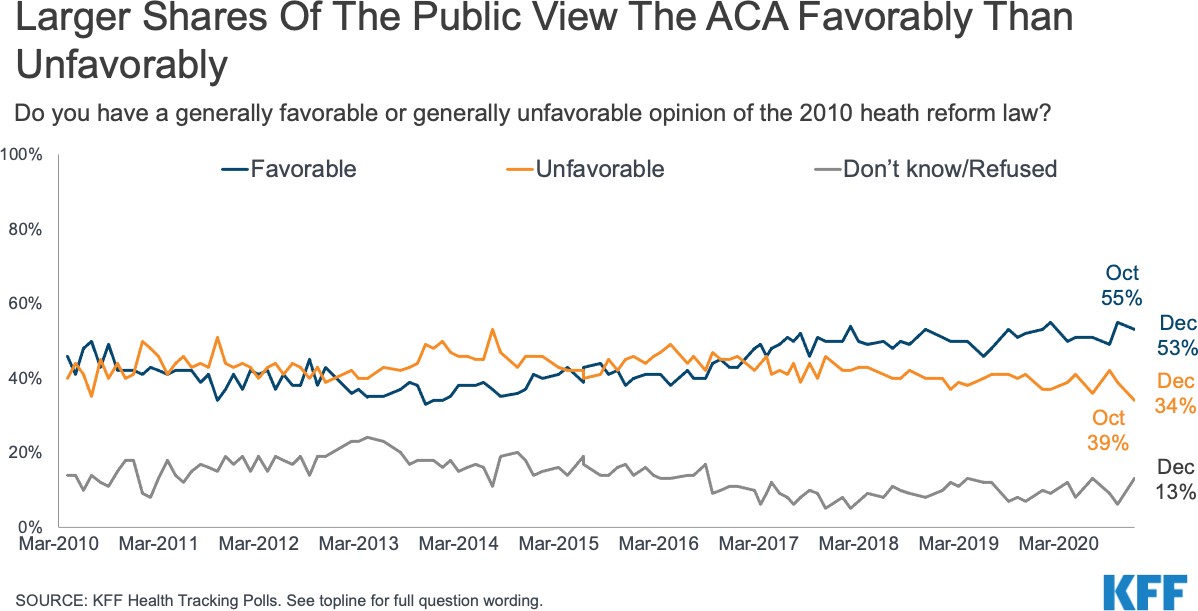76 6.5 – CASE STUDY: IMPLEMENTING THE AFFORDABLE CARE ACT
CASE STUDY: IMPLEMENTING THE AFFORDABLE CARE ACT
As outlined above, six factors affect policy implementation and three groups are responsible for implementing it. The first factor, source of policy, played a major role in the implementation of Obamacare. The partisan backdrop that grips the country under President Trump is nothing new and existed during President Obama’s eight years in office. Policy proposals by Democrats were met with staunch opposition. Regarding the Obama agenda, then Speaker of the House John Boehner said, “We’re going to do everything—and I mean everything we can do—to kill it, stop it, slow it down, whatever we can” (Barr, 2010). Likewise, Senate Minority Leader Mitch McConnell is quoted by the National Journal saying, “The single most important thing we want to achieve is for President Obama to be a one-term president” (Barr, 2010). The second factor, clarity of policy, was a major issue due to misinformation campaigns from the right and the Democrat’s inability to deliver their message in a meaningful way. Speaker Pelosi, in an interview with Sarah Kliff (2017), expressed her one regret regarding the law: other Democrats not stepping up to defend the law, thus leading to “a sea of misinformation about her signature legislative achievement.” One misinformation campaign was led by Americans for Prosperity, a conservative advocacy group. They began running campaigns in 2013 to cast doubt on the law (Peters, 2013). The messaging battle created confusion regarding the policy, which may have had a detrimental impact when it comes to political support, which leads us to the third, and arguably most important, factor: support for the policy.In the case of Obamacare, the federal government is responsible for overseeing implementation (the manager). The ACA relied on both federal and state governments to successfully implement the law. The bill involved all 50 state governors, insurance commissioners, and Medicaid directors (the doers). The continued debate over Obamacare from its inception has been mired by partisan politics. Further complicating the implementation process was public support for the policy. More respondents, on average, have expressed disapproval of the law from its passage until a drastic shift after President Trump took office (Kirzinger, Muñana, and Brodie, 2019).

Figure 6.3: Larger Share of Public View ACA Favorably than Unfavorably Source: Kaiser Family Foundation Attribution: Kaiser Family Foundation License: CC BY-NC-ND 4.0
Beyond public support, successful implementation also relies on the support of those implementing the policy. Even though the Democrats had control of the White House, and thus a great influence on bureaucratic behavior, implementation relied heavily on state support. Much like public support, state support was drawn on partisan lines. The ACA contained provisions that were left up to the states, including establishing insurance exchanges and expanding Medicaid. Only thirteen states have created state-based marketplaces, six have state-based marketplaces using the federal platform, and the remaining states rely on the federally facilitated marketplace (KFF, n.d.). State-based marketplaces perform all functions for the individual market, and consumers apply for coverage on websites maintained by each state. The federally facilitated marketplace, on the other hand, relies on HHS to perform all functions, and consumers apply for coverage via the federal Healthcare.gov site. The middle ground, state-based marketplaces using the federal platform, functions the same as state-based marketplaces, but consumers use Healthcare.gov to enroll in coverage.
The major provision contested by states is Medicaid expansion. The law mandated expansion, but the mandate was challenged in National Federation of Independent Business v. Sebelius (2012). The ruling declared the mandate unconstitutional by violating the 10th Amendment, thus leaving governors to decide whether their state would expand Medicaid. As of 2019, fourteen states have opted out of expansion. However, it is worth noting some states, including Georgia and Kansas, are considering expansion while others, including Missouri and Wyoming, have plans to place their expansion decisions on a future ballot (KFF, 2019).
The fourth provision, policy complexity, has been covered in the previous three factors. As you can see, there are many moving parts at various levels of government that rely on extensive oversight and coordination, both vertical and horizontal. The coordination dilemmas are largely managed by the Department of Health and Human Services (HHS). A report in 2012 by the Office of the Inspector General (a fixer) discussed the challenges with implementation. HHS worked as an intermediary between federal and state governments as well as coordinating the necessary federal agencies. Furthermore, according to the report, the “department would be forging new relationships with private insurers, providers, employers and consumers, all of whom will need clear information about benefits and responsibilities under ACA programs.”
Lastly, the final two factors, incentives and resource allocation, work together in administering the program at the state level. The law required the federal government to pay for 100 percent of Medicaid expansion from 2014 to 2016 with a gradual drop from 2016 to 2020, when the government would continue paying 90% as long as the law was in place. Beyond state incentives and resource allocation, individuals were incentivized to buy into the program through the provisions below. The number in parentheses represents the percentage of people who think it is very important they be kept in place, according to a Kaiser Family Foundation Poll (Kirzinger, Muñana, and Brodie, 2019):Denying coverage for people with pre-existing conditions (72%).Denying coverage to pregnant women (71%).Prohibiting providers from charging sick people more (64%).Prohibiting lifetime limits (62%).Allowing young adults to stay on parents’ insurance until age 26 (51%).All-in-all, the ACA is a complex policy that still leads to heated debates in the halls of Congress and around tables at Thanksgiving. One of the many promises by Republicans during the 2016 election was to repeal and replace the Affordable Care Act. It has been three years, yet the law remains in place.

